check engine light CHEVROLET LUMINA 1993 1.G User Guide
[x] Cancel search | Manufacturer: CHEVROLET, Model Year: 1993, Model line: LUMINA, Model: CHEVROLET LUMINA 1993 1.GPages: 324, PDF Size: 17.44 MB
Page 141 of 324
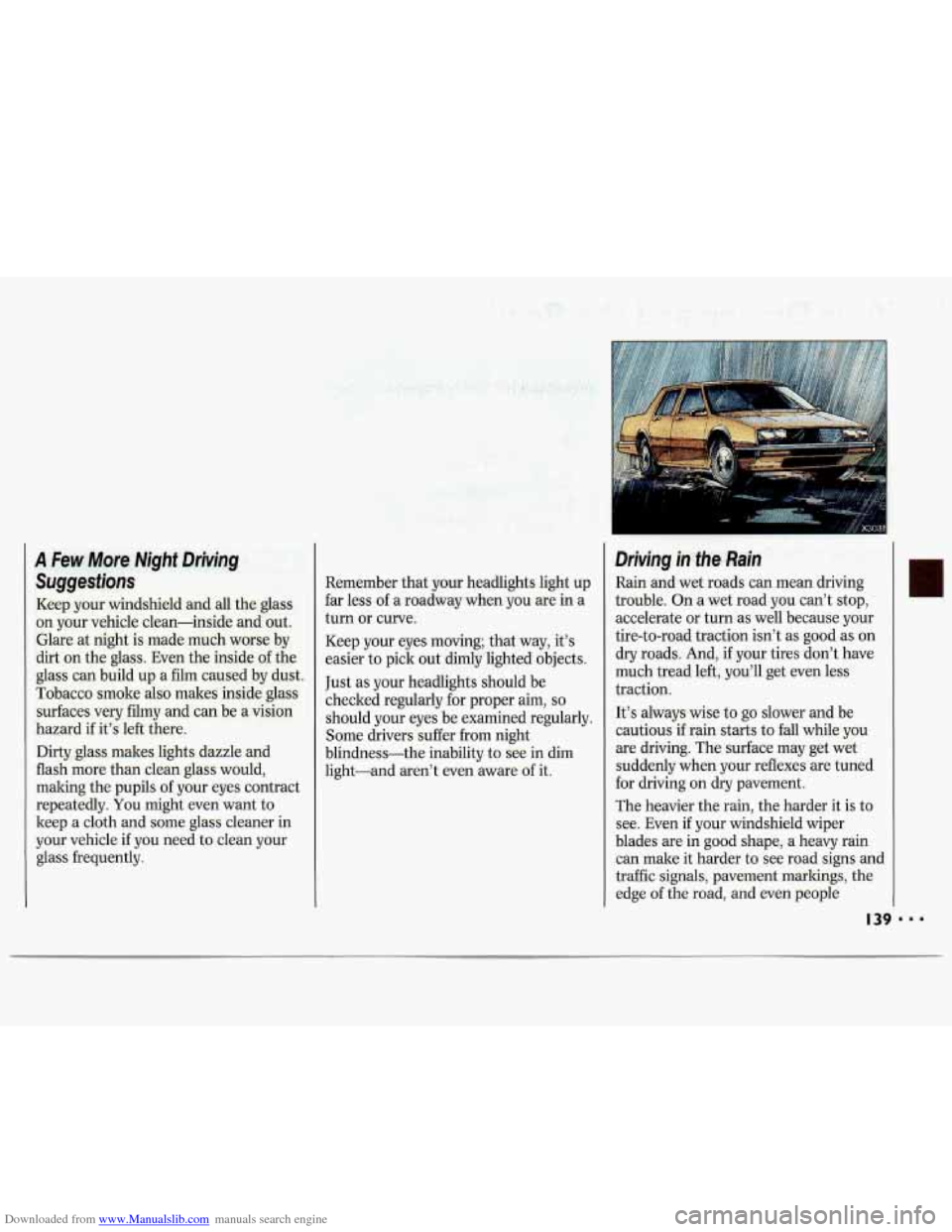
Downloaded from www.Manualslib.com manuals search engine Remember that your headlights light up
far less of
a roadway when you are in a
turn or curve.
Keep your eyes moving; that way, it’s
easier to pick out dimly li@ted objects.
Just as
your headlights should be
checked regularly for proper aim,
so
should your eyes be examined regularly. Some drivers suffer
from night
blindness-the inability to see in dim
light-and aren’t even aware
of it. Rain and
wet roads can mean driving
trouble.
Qn a wet road.you can’t stop,
accelerate or turn
as well because your
tire-to-road traction isn’t as good
as on
dry roads. And, ifyour tires don’t have
much tread lea, you’ll get even less
traction.
It’s always wise to go slower and be
cautious
if rain starts to fall while you
are driving. The surface may get wet
suddenly when your reflexes are tuned
for driving on dry pavement.
The heavier the rain, the harder it is to
see. Even
if your windshield wiper
blades are in good shape, a heavy rain
can make it harder to
see road signs and
traffic signals, pavement markings, the
edge of the road, and even people
Page 145 of 324

Downloaded from www.Manualslib.com manuals search engine course you want to respect another’s
property, but you might need to put
something between you and moving
vehicles-space, trees, telephone poles,
a private driveway, anything that
removes you from other traffic.
If visibility
is near zero and you must
stop but are unsure whether you are
away from the road, turn your hghts on,
start your hazard warning flashers, and
sound your horn at intervals or when
you hear approaching traffic.
Pass other vehicles in fog only if you
can see far enough ahead to pass safely.
Even then, be prepared to delay your
pass if you suspect the fog
is worse up
ahead.
If other vehicles try to pass you,
make it easy for them.
Cify Driving
One of the biggest problems with city
streets is the amount of traffic on them.
You’ll want to watch
out for what the
other drivers are doing and pay
attention to traf€ic signals.
Here are ways to increase your safety in
city driving:
Know the best way to get to where
you are going.
Try not to drive around
trying to pick out a familiar street or
landmark. Get
a city map and plan
your trip into an unlmown part of the
city
just as you would for a cross-
country trip.
Try to use the freeways that rim and
crisscross most large cities. You’ll
save time and energy. (See the next
section,
Freway Driving.)
Treat a green light as a warning
signal.
A traffic light is there because
the corner is busy enough to need
it.
When a light turns green, and just
before you start to move, check both
ways for vehicles that have not
cleared the intersection or may be
running the red light.
Obey all posted speed limits. But
remember that they are for ideal road,
weather and visibility conditions.
You
may need to drive below the posted
limit in bad weather or when visibility
is especially poor.
Pull to the right (with care) and stop
clear of intersections when you see or
hear emergency vehicles.
Page 146 of 324
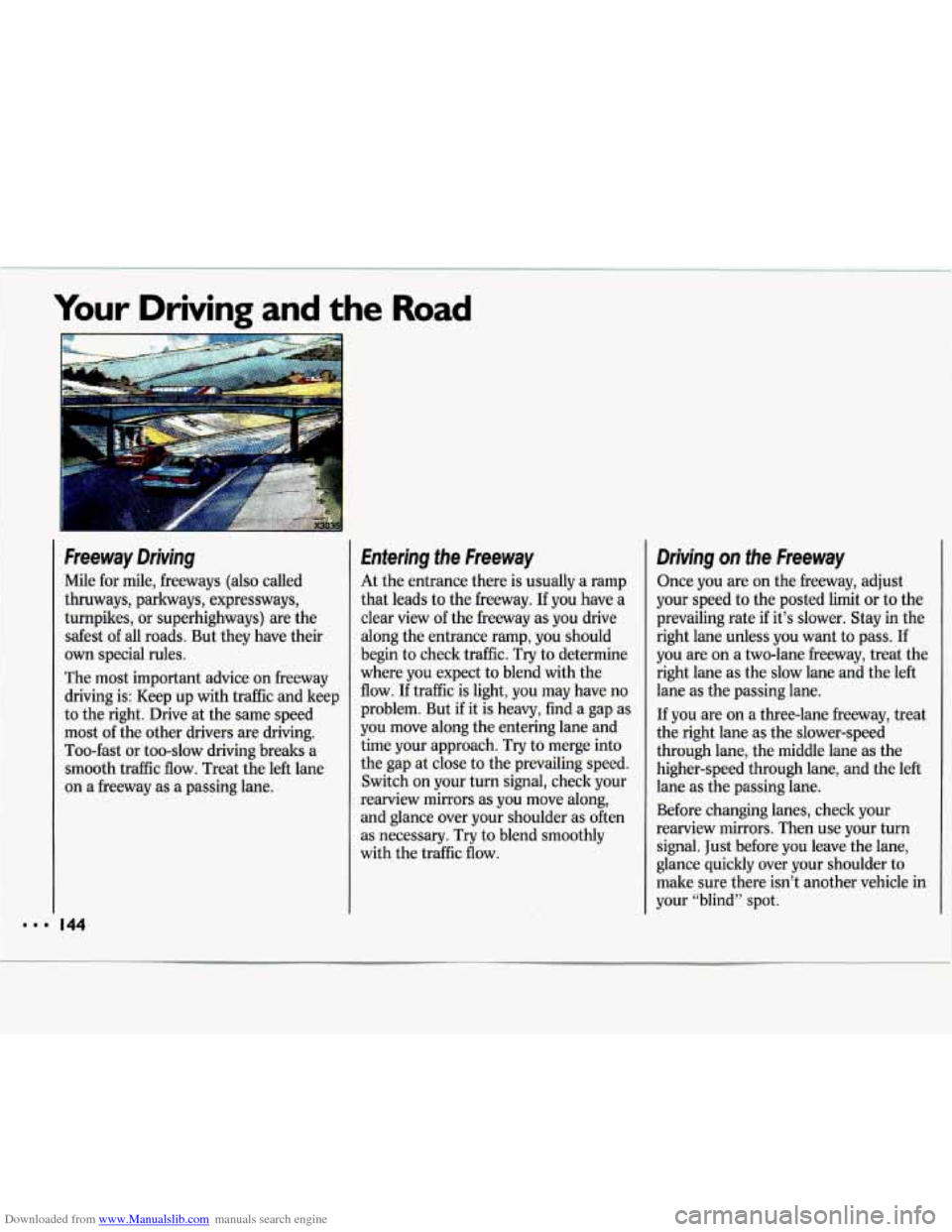
Downloaded from www.Manualslib.com manuals search engine Your Driving and the Road
Freeway Driving
Mile for mile, freeways (also called
thruways, parkways, expressways,
turnpikes, or superhighways) are the
safest
of all roads. But they have their
own special rules.
The most important advice on freeway
driving is: Keep up with traffic and keep
to the right. Drive at the same speed
most of the other drivers are driving.
Too-fast or too-slow driving breaks a
smooth traffic flow. Treat the left lane
on a freeway as a passing lane.
I44
Entering the Freeway
At the entrance there is usually a ramp
that leads to the freeway.
If you have a
clear view of the freeway as you drive
along the entrance ramp, you should
begin to check traffic. Try to determine
where you expect to blend with the
flow. If traffic is light, you may have no
problem. But if it is heavy, find a gap as
you move along the entering lane and
time your approach. Try to merge into
the gap at close to the prevailing speed.
Switch on your turn signal, check your
rearview mirrors
as you move along,
and glance over your shoulder as often
as necessary.
Try to blend smoothly
with the traffic flow.
Driving on the Freeway
Once you are on the freeway, adjust
your speed to the posted limit or to the
prevailing rate
if it’s slower. Stay in the
right lane unless you want to pass. If
you are on a two-lane freeway, treat the
right lane as the slow lane and the left
lane as the passing lane.
If you are on a three-lane freeway, treat
the right lane as the slower-speed
through lane, the middle lane as the
higher-speed through lane, and the left
lane as the passing lane.
Before changing lanes, check your
rearview mirrors. Then use your turn
signal.
Just before you leave the lane,
glance quickly over your shoulder to
make sure there isn’t another vehicle in
your “blind” spot.
Page 148 of 324

Downloaded from www.Manualslib.com manuals search engine Your Driving and the Road
‘I
Driving a long Distance
Although most long trips today are
made on freeways, there are still many
made on regular highways.
Long-distance driving on freeways and
regular highways is the same in some
ways. The trip has to be planned and
the vehicle prepared, you drive at
higher-than-city speeds, and there are
longer turns behind the wheel. You’ll
enjoy your trip more if you and your
vehicle are in good shape. Here are
some tips for a successful long trip.
I46
Before leaving on a Long Trip
Make sure you’re ready. Try to be well
rested. If you must start when you’re
not fresh-such as after a day’s work-
don’t plan to make too many miles that
first part
of the journey. Wear
comfortable clothing and shoes you can
easily drive in.
Is your vehicle ready for a long trip?
If
you keep it serviced and maintained, it’s
ready to go. If it needs service, have it
done before starting out. Of course,
you’ll find experienced and able service
experts in Chevrolet dealerships all
across North America. They’ll be ready
and willing to help
if you need it. Here
are some things you can check
before a trip:
Windshield Washer Fluid: Is the
reservoir full? Are all windows clean
inside and outside?
shape?
Have you checked all levels?
lenses clean?
Wiper Blades: Are they in good
Fuel, Engine Oil, Other Fluids:
Lights: Are they all working? Are the I
Tires: They are vitally important to a I
safe, trouble-free trip. Is the tread
good enough for long-distance
driving? Are the tires all inflated to
the recommended pressure?
weather outlook along your route? Should you delay your trip a short
time to avoid a major storm system?
Maps: Do you have up-to-date maps?
Weather Forecasts: What’s the
Page 149 of 324

Downloaded from www.Manualslib.com manuals search engine On the Road
Unless you are the only driver, it is good
to share the driving task with others.
Limit turns behind the wheel to about
100 miles (160 km) or two hours at a
sitting. Then, either change drivers or
stop for some refreshment like coffee,
tea or soft drinlts and some limbering
up. But do stop and move around. Eat
lightly along the way. Heavier meals
tend to make some people sleepy.
On two-lane highways or undivided
multilane highways that do not have
controlled access, you’ll want to watch
for some situations not usually found
on freeways. Examples are: stop signs
and signals, shopping centers with
direct access to the highway, no passing
zones and school zones, vehicles
turning left and right off the road,
pedestrians, cyclists, parked vehicles, and even animals.
Highway Hypnosis
Is there actually such a condition as
“highway hypnosis”? Or is it just plain
falling asleep at the wheel? Call it
highway hypnosis, lack of awareness, or
whatever.
There is something about an easy
stretch of road with the same scenery,
along with the hum of the tires on the
road, the drone of the engine, and the
rush of the wind against the vehicle that
can make you sleepy. Don’t let it
happen to you! If it does, your vehicle
can leave the road in
less than a second,
and you could crash and be injured.
What can you do about highway
hypnosis? First, be aware that it can
happen.
Then here are some tips:
Make sure your vehicle is well
ventilated, with a comfortably cool interior.
Keep your eyes moving. Scan the road
ahead and to the sides. Check your
rearview mirrors frequently and your
instruments from time to time. This
can help you avoid a fixed stare.
Wear good sunglasses in bright light.
Glare can cause drowsiness. But don’t
wear sunglasses at night. They will
drastically reduce your overall vision
at the very time you need all the
seeing power you have.
If you get sleepy, pull off the road into
a rest, service, or parking area and
take a nap, get some exercise, or both.
For safety, treat drowsiness on the
highway as an emergency.
As in any driving situation, keep pace
with traffic and allow adequate
following distances.
Page 161 of 324
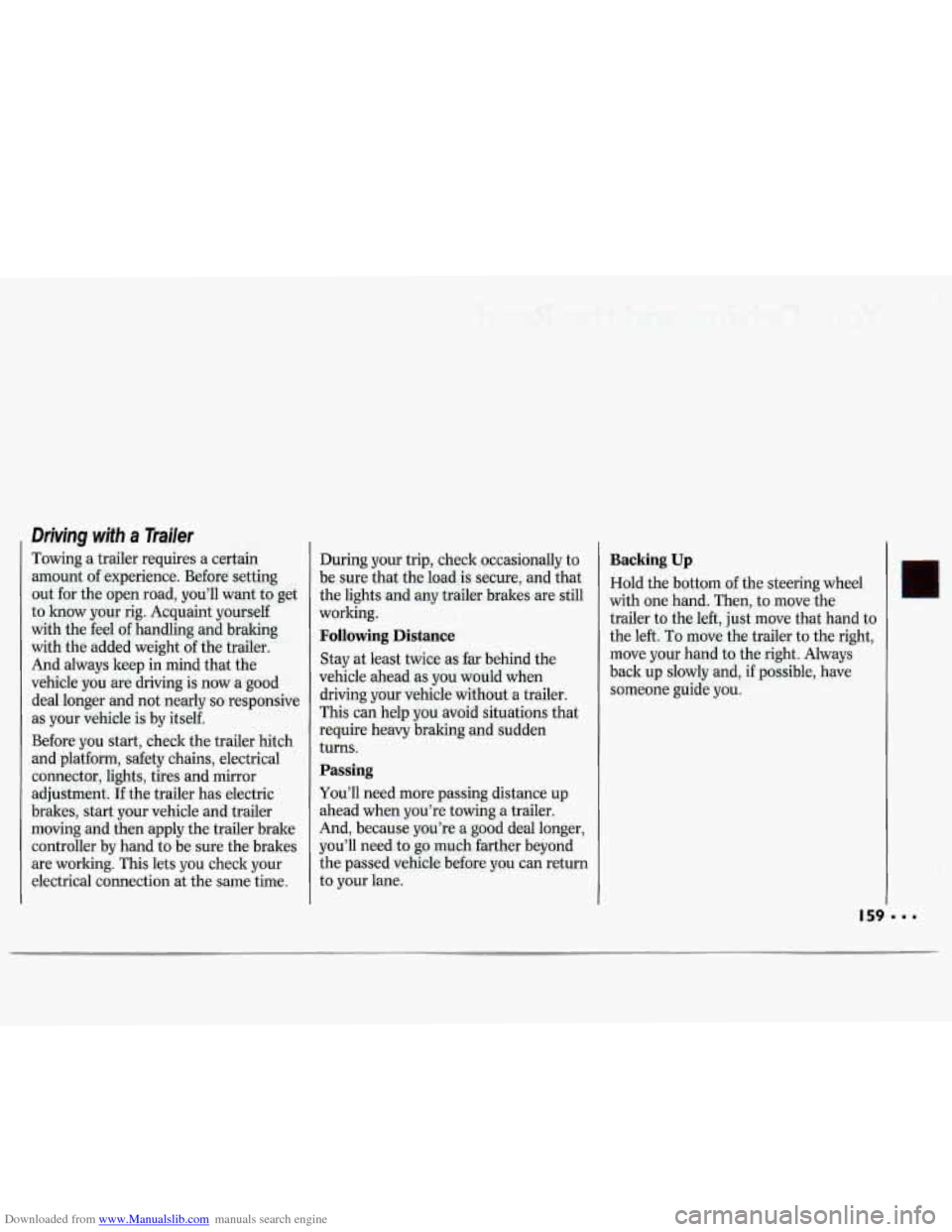
Downloaded from www.Manualslib.com manuals search engine Driving with a Trailer
Towing a trailer requires a certain
amount of experience. Before setting out for the open road, you’ll want to get
to know your rig. Acquaint yourself
with the feel of handling and braking
with the added weight of the trailer.
And always keep in mind that the
vehicle you are driving is now
a good
deal longer and not nearly
so responsive
as your vehicle is by itself.
Before you start, check the trailer hitch
and platform, safety chains, electrical connector, lights, tires and mirror
adjustment. If the trailer has electric
brakes, start your vehicle and trailer
moving and then apply the trailer brake
controller by hand to be sure the brakes
are worling. This lets you check your
electrical connection at the same time. During your
trip, check occasionally to
be sure that the load is secure, and that
the lights and any trailer brakes are still
working.
Following Distance
Stay at least twice as far behind the
vehicle ahead
as you would when
driving your vehicle without a trailer.
This can help you avoid situations that
require heavy braking and sudden
turns.
Passing
You’ll need more passing distance up
ahead when you’re towing a trailer.
And, because you’re a good deal longer,
you’ll need to go much farther beyond
the passed vehicle before you can return
to your lane.
Backing Up
Hold the bottom of the steering wheel
with one hand. Then, to move the
trailer to the left, just move that hand
to
the left. To move the trailer to the right,
move your hand to the right. Always
back up slowly and, if possible, have
someone guide you.
Page 162 of 324
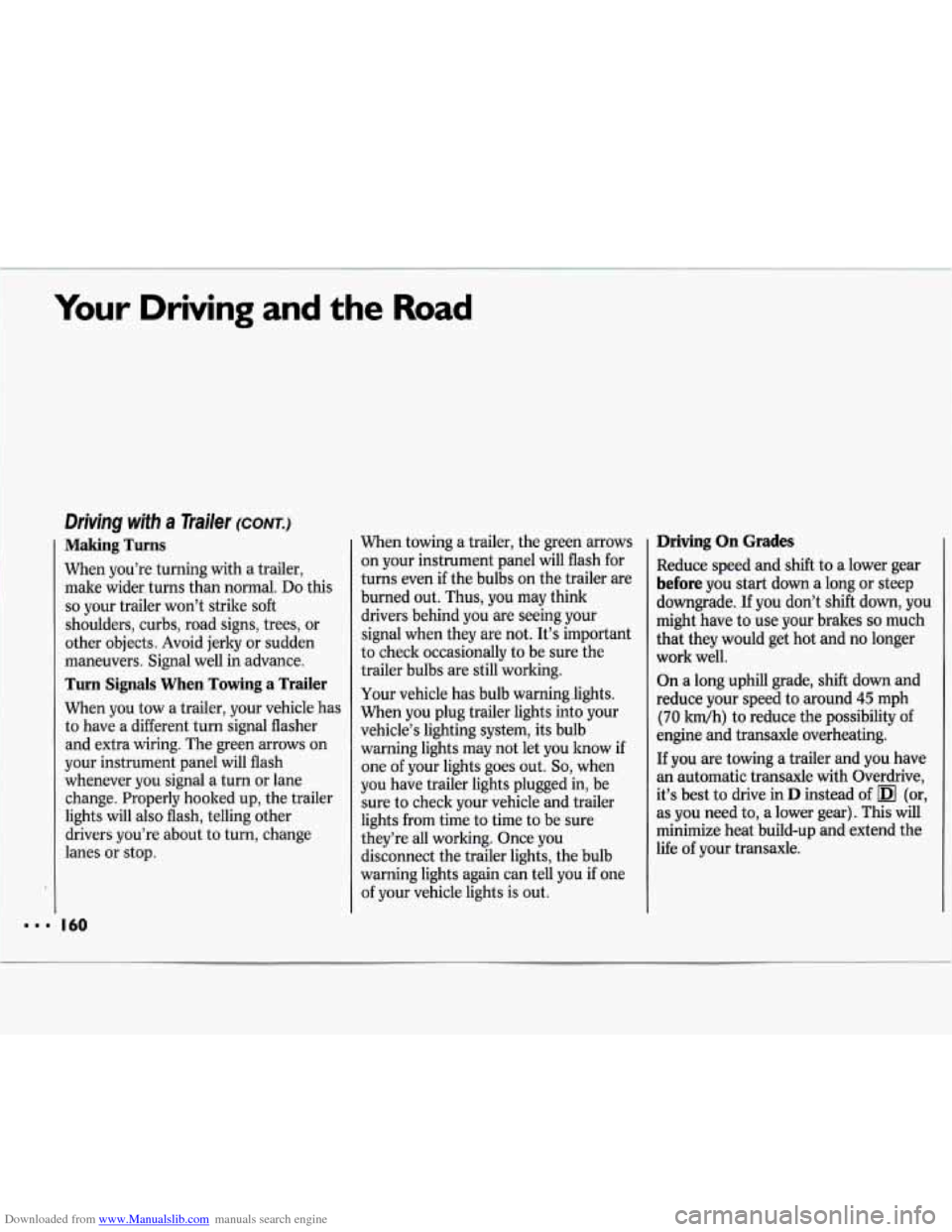
Downloaded from www.Manualslib.com manuals search engine Your Driving and the Road
Driving with a Trailer (CONT.)
Making Turns
When you’re turning with a trailer, make wider turns than normal. Do this
so your trailer won’t strike soft
shoulders, curbs, road signs, trees, or
other objects. Avoid jerky or sudden
maneuvers. Signal well in advance.
Turn Signals When Towing a Trailer
When you tow a trailer, your vehicle has
to have a different turn signal flasher
and extra wiring. The green arrows on
your instrument panel will flash
whenever you signal a turn or lane
change. Properly hooked up, the trailer
lights will also flash, telling other
drivers you’re about to turn, change
lanes or stop.
I60
When towing a trailer, the green arrows
on your instrument panel will flash for
turns even if the bulbs on the trailer are
burned out. Thus, you may think
drivers behind you are seeing your
signal when they are not. It’s important
to check occasionally to be sure the
trailer bulbs are still working.
Your vehicle has bulb warning .lights.
When you plug trailer lights into your
vehicle’s lighting system, its bulb
warning lights may not let you know if
one
of your lights goes out. So, when
you have trailer lights plugged in, be
sure to check your vehicle and trailer
lights from time to time to be sure
they’re all working. Once you disconnect the trailer lights, the bulb
warning lights again can tell you if one
of your vehicle lights
is out.
Driving On Grades
Reduce speed and shift to a lower gear
before you start down a long or steep
downgrade. If you don’t shift down,
you
might have to use your brakes so much
that they would get hot and no longer
work well.
On a long uphill grade, shift down and
reduce your speed to around
45 mph
(70 Wh) to reduce the possibility of
engine and transaxle overheating.
If you are towing a trailer and you have
an automatic transaxle with Overdrive,
it’s best to drive in
D instead of (or,
as you need to, a lower gear). This will
minimize heat build-up and extend the
life of your transaxle.
Page 169 of 324
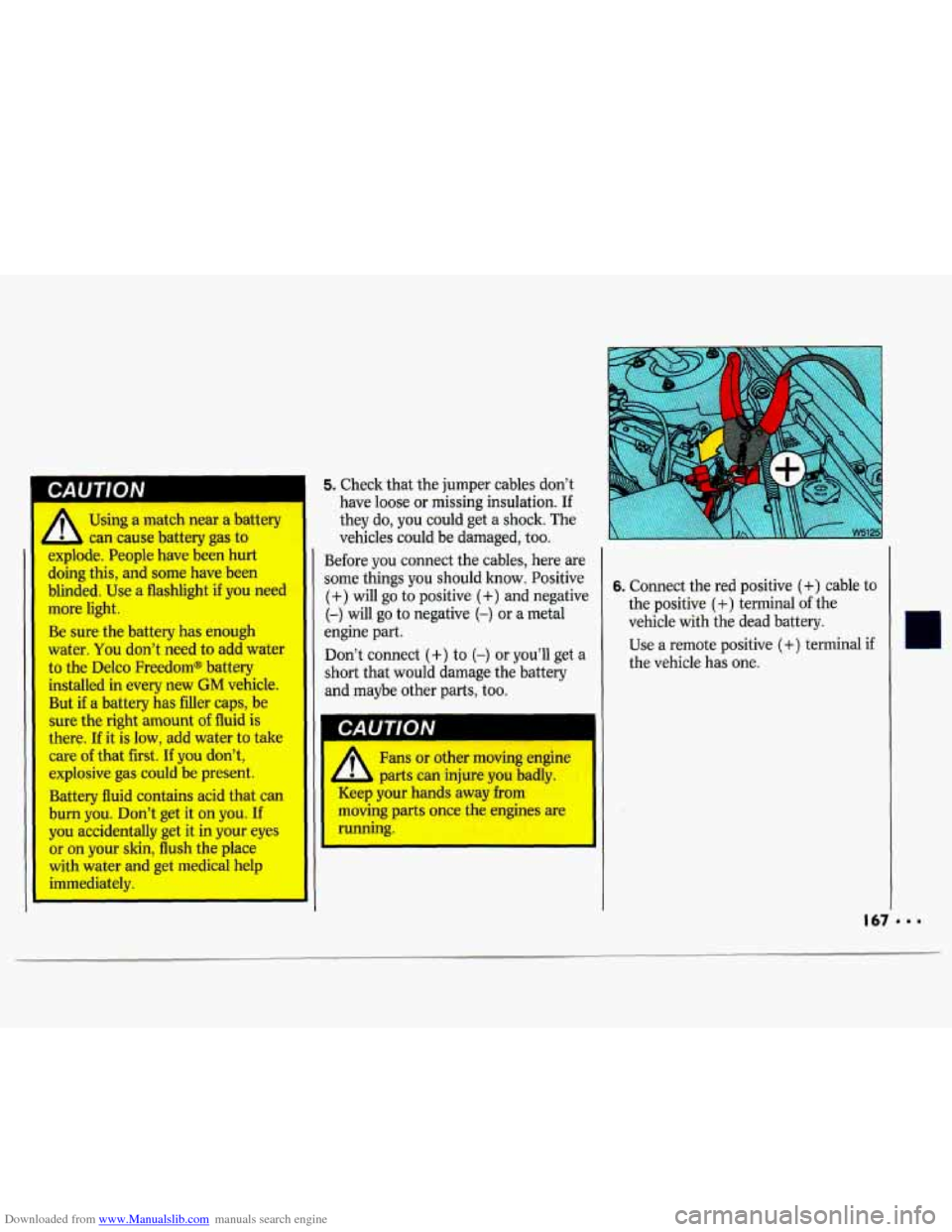
Downloaded from www.Manualslib.com manuals search engine bHU 1 lUlY
Using a match near a battery
4 L can cause battery gas to
explode. Peopk have been hurt
doing this, and some have been
blinded. Use a flashlight if you need
more light.
Be sure the battery has enough
water. You don’t need to add water
to the Delco Freedom@ battery
installed in every new GM vehicle.
But if a battery has filler caps, be
sure the right amount of fluid is
there. lf it is low, add wafer to take
care of that first. If you don’t,
explcrsive gas could be present.
Battery fluid contains acid that can
burn you. Don’t get it on you. If
you accidentally get it in your eyes
or on your skin, flush the place
with water and get medical help
immediately.
5. Check that the jumper cables don’t
have loose or missing insulation.
If
they do, you could get a shock. The
vehicles could be damaged, too.
Before you connect the cables, here are
some things you should know. Positive
(+) will go to positive (+) and negative
(-) will go to negative (-) or a metal
engine part.
Don’t connect
(+) to (-) or you’ll get a
short that would damage the battery
and maybe other parts, too.
Fans or other moving engine
A parts can injure you badly.
Keep your hands away
from
moving parts once the engines are
running.
6. Connect the red positive (+) cable to
the positive
(+) terminal of the
vehicle with the dead battery.
Use a remote positive
(+) terminal if
the vehicle has one.
Page 189 of 324
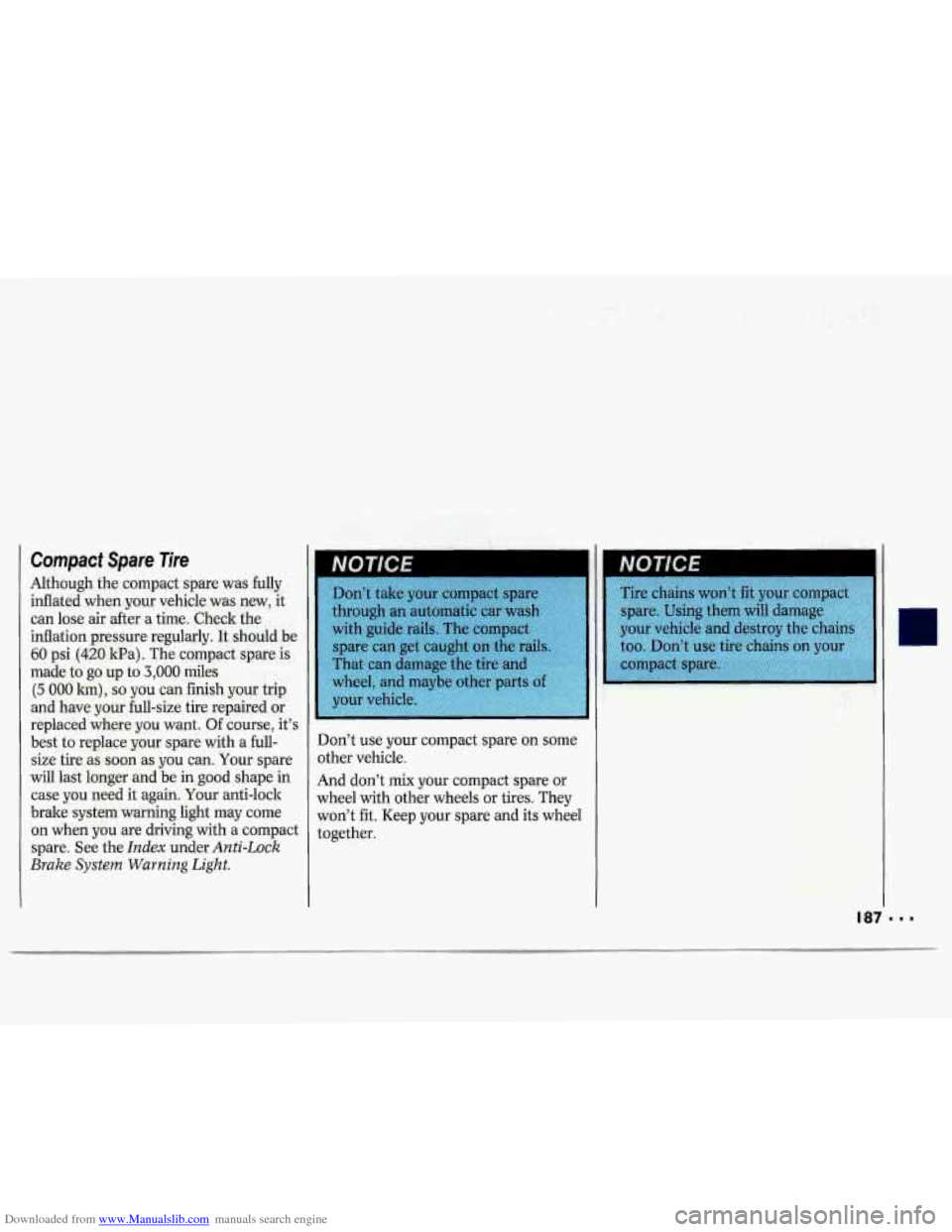
Downloaded from www.Manualslib.com manuals search engine Compact Spare Tire
Although the compact spare was fully
inflated when your vehicle was new, it
can lose air after a time. Check the
inflation pressure regularly. It should be
60 psi (420 kPa). The compact spare is
made to go up to
3,000 miles
(5 000 Inn), so you can finish your trip
and have
your full-size tire repaired or
replaced where
you want. Of course, it’s
best to replace your spare with a full-
size tire as soon as you can. Your spare
will last longer and be in good shape in
case you need it again. Your anti-lock
brake system warning light may come
on when you are driving with a compact
spare. See the
Index under Anti-Lock
Brake System Warning Light.
Don’t use your compact spare on some
other vehicle.
And don’t
mix your compact spare or
wheel with other wheels or tires. They
won’t fit. Keep your spare and its wheel
together.
Page 213 of 324
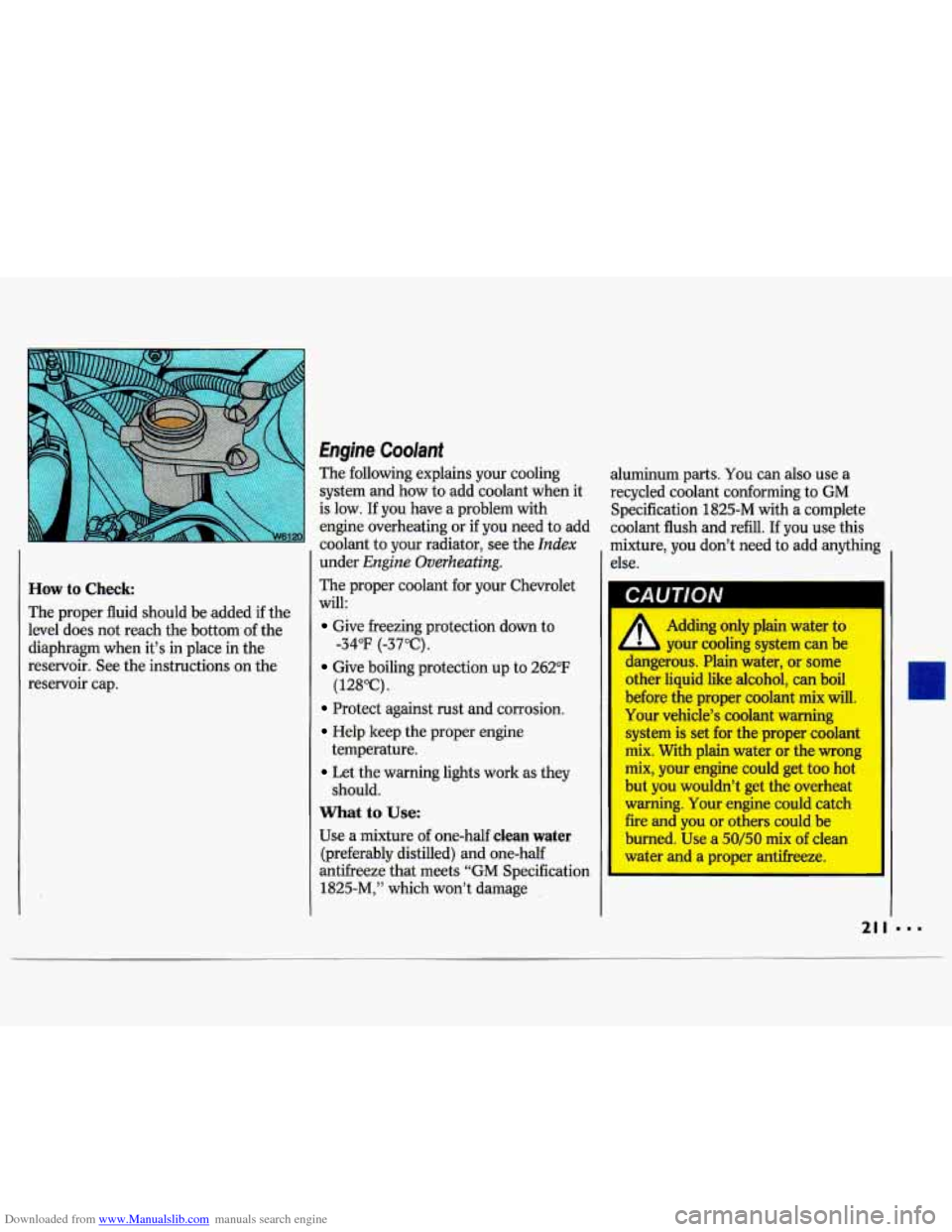
Downloaded from www.Manualslib.com manuals search engine How to Check
The proper fluid should be added if the
level does not reach the bottom of the
diaphragm when it’s
in place in the
reservoir. See the instructions on the
reservoir cap.
Engine Coolant
The following explains your cooling
system and how to add coolant when it
is low. If you have a problem with
engine overheating or
if you need to add
coolant to your radiator, see the
Index
under Engine Overheating.
The proper coolant for you1 ~ ~ ~ _et
will:
Give freezing protection c, .m to
Give boiling protection up to 262°F
Protect against rust and corrosion.
Help keep the proper engine
Let the warning lights work as they
What to Use:
Use a mixture of one-half clean water
(preferably distilled) and one-half
antifreeze that meets
“GM Specification
1825-M,” which won’t damage ,
-34°F (-37°C).
(128°C).
temperature. should. aluminum
parts. You can
also use a
recycled coolant conforming to
GM
Specification 1825-M with a complete
coolant flush and refill. If you use this
mixture, you don’t need to add anything
else.
I
9
Adding only plain water to
your cooling system can be
dangerous. Plain water, or some
other liquid like alcohol, can boil
before the proper coolant mix will.
Your vehicle’s coolant warning
system is set for the proper coolant
mix. With plain water or the wrong
mix, your engine could get too hot
but you wouldn’t get the overheat
warning. Your engine could catch fire and you or others could be
burned. Use a
50/50 mix of clean
water and a proper antifreeze.